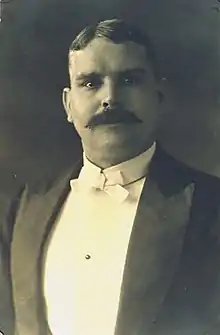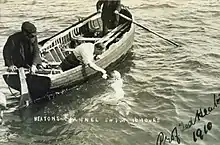Ted Heaton
Edmund Caunce Nowell 'Ted' Heaton (late 1872 – 19 September 1937) was a British diver born in Liverpool, England. He is notable for his small tank diving displays during the late 19th century and for his several unsuccessful attempts to swim the English Channel during the early 20th century. His swimming efforts earned him a role as a superintendent of his local swimming baths.
 Portrait of Ted Heaton c1910 | |
| Personal information | |
|---|---|
| Full name | Edmund Caunce Nowell Heaton[1] |
| Born | 1872 Liverpool, England |
| Died | September 19, 1937 (aged 64–65) Southport, Lancashire |
| Resting place | Allerton Cemetery, Liverpool |
| Spouse(s) | Elizabeth Emery
(m. 1890–1892)Julia Rolling
(m. 1893; suicide 1927) |
| Sport | |
| Country | Great Britain |
| Sport | Diving, Swimming |
Early life
Heaton was born in the fourth quarter of 1872[2] as the son of a book-keeper for Liverpool Docks. Heaton trained as a printer's compositor, which he worked on irregularly before becoming a professional swimmer around the 1890s.[3]
Swimming and diving
19th century
Heaton wrote to The Era in May 1896, after they erroneously stated that Professor Bracken held the unique position as a small tank champion high diver. Heaton disputed the statement, stating that he was the originator of small tank diving, having performed it at all the circuses and noting he was "the only small tank diver".[4] Following the death of fellow high diver Tommy Burns in July 1897, Heaton organised a charity dive from Rhyl Pier to help raise money for the family to pay for the funeral costs, and he sent them the sum of £3 and 10 shillings from the proceeds.[5] His performance in the evening was observed by over 2,000 people on the pier and 10,000 on the beach, where he dived with his body in flames.[6]
In January 1898, he dived into Belfast harbour from a specially constructed 50 feet (15 m) high platform at Queens Bridge and was witnessed by around 15,000 spectators.[7] The following month, having been growing in popularity, he was engaged to perform a dive at the Cirque Raney, in Lyons, France from a 50 ft height while enveloped in flames, into a tank measuring just 16 feet (4.9 m) by 10 feet (3.0 m).[8] At the Scottish Zoo in September 1898, he was "a capital hit" when secured to perform a 50 ft dive into a small water tank just 42 inches (1,100 mm) deep, while "enveloped in flames from a large number of fireworks". His performance drew a big audience to the zoo.[9]
20th century
Heaton would sometimes combine swimming and diving into a single event, such as in June 1905 when he swam 10 miles (16 km) from Eastham to New Brighton, where the climax was then a dive off New Brighton Pier.[10]
Attempts to cross the channel
During the 1900s, he made several unsuccessful attempts to swim the English Channel.[3] His first attempt in July 1905 was reported to have started well, where he entered the water at 7:41am and swam the breaststroke at pace "amid an outburst of cheering", with fine weather conditions and a "scorching sun". His attempt was alongside Annette Kellerman, who also attempted to swim the channel at the same time, but she left the water five or six miles out due to sea-sickness. Despite swimming through strong currents, Heaton stopped at 2:30pm in a state of sickness, six miles from the shore,[11] having to abandon his efforts due to "taking a mouthful of oil which was floating on the water".

He prepared for another attempt to cross the channel in 1907, and trained "vigorously" for the effort. In late June, he attempted to beat the Wallasey ferryboat on the New Brighton to Egremont service, which was met with great interest from the boat's passengers. Despite not beating the ferryboat, which completed the journey in 20 minutes, Heaton swam the journey in just under 28 minutes, and after a dressing "went for a brisk walk along the sands".[12] Two months later in early August, he made another attempt to cross the channel, this time with Jabez Wolffe. He started his swim at 8:55am and was 4 miles (6.4 km) away from land by 11am. The conditions were described as calm, with some fog haze caused by the heat which developed into something denser. Conditions for the next hour were "very unpleasant" until a light wind cleared the fog. As the swim developed into something resembling a race between the two swimmers, the weather turned around 2:30pm with a darker sky that developed into a thunderstorm. Once this passed, the swimmers continued in their efforts, although due to a thick haze, the boats supporting Heaton lost sight of him for a time. Unable to see the coast and with no goal visible, he chose to give up his attempt although when retrieved from the water was "in splendid condition physically" and he noted that another attempt would be made when the tides were next suitable.[13] He made a fourth attempt several weeks later but left the water after just three hours of swimming due to choppy waters.[14] In August 1909 on his fifth attempt, he reached within 1.75 miles (2.82 km) of the French coast but adverse tides forced him to give up, having been in the water for over 15 hours by that time.[15]
In early September 1910, he again unsuccessfully attempted to swim the English Channel, coming within four miles of the French shore and being retrieved from the channel in an exhausted state having spent sixteen hours in the water.[16] On his seventh and what would be his final attempt to swim the channel during August 1911, he swam in sea that "was beautifully smooth and warm, with just a slight breeze". Heaton entered the water around 8:20am from the supporting boat which was also carrying his wife. Around an hour after entering the water, the wind increased and after over 10 hours swimming at 6:40pm, abandoned his effort and returned to Dover. He came to within 5 miles (8.0 km) of the French coast.[17]
Other roles
In August 1905,[18] he was appointed "by an overwhelming majority" as the superintendent of Cornwallis Street baths, earning a salary of £120 a year despite a councillor opposing the appointment on the basis that his "only recommendation was his attempt to swim the channel".[19] The role, which he secured from among a number of applicants, included a house, coal and gas and could rise to £150 per annum.[18]
He served in military during World War I in the Essex Regiment, but was discharged in December 1919 on disability grounds.[20]
In 1932, he was advertising himself as "Liverpool's famous swimming master".[21]
Personal
Heaton's first marriage was to Elizabeth Emery in May 1890, but she died shortly after.[22] He then married Julia Rolling on 4 December 1893 at St Peter in Liverpool[23] and had two sons, Edmund James Whittaker (b. c1894), Regnialan (b. c1905) and a daughter, Ellen (b. c1896). According to the 1901 census, he had a younger brother Thomas Heaton, 16 years his junior who was living with him at the time.[24][1] His father was Edward Whittaker Heaton and was listed as a widower living with his son's family during the 1911 census.[25] His wife Julia committed suicide in 1927 after swallowing poison whilst of unsound mind.[26] He was known to have a friendship with cricketer Frank Sugg.[27]
He died on 19 September 1937 in Southport Infirmary while on a visit to the seaside town, leaving effects worth £135, 2 shillings and 1 pence.[1][28] He was buried at Allerton Cemetery on 22 September 1937.[29]
References
Citations
- "England & Wales, National Probate Calendar, Index of Wills and Administration". National Probate Calendar. 15 November 1937. Retrieved 7 April 2022.
- "England & Wales, Civil Registration Birth Index". Civil Registration Birth Index. 1872. Retrieved 7 April 2022.
- "Heaton, Edmund Caunce Nowell 'Ted'". Channel Swimming Dover. Retrieved 8 April 2022.
- "Tank Diving: To the editor of The Era". The Era. 23 May 1896. p. 16.
- "Professor Lloyd and the Late Tommy Burns". Evening Express. 14 July 1897. p. 4.
- "Ted Heaton's dives". Liverpool Echo. 25 July 1935. p. 10.
- "Heaton dives from Queen's Bridge". Post and Times. 15 January 1898. p. 6.
- "A Liverpool High Diver in France". Liverpool Daily Post. 5 February 1898. p. 7.
- "The Scottish Zoo". The Daily Record. 20 September 1898. p. 8.
- "Great 10-Mile Swim". Liverpool Echo. 17 June 1905. p. 7.
- "Cross-channel swim - Double attempt ends in failure". The Newcastle Daily Chronicle. 27 July 1905. p. 7.
- "Liverpool Swimmer and the channel - Professor Heaton's Practice Effort". Liverpool Daily Post and Liverpool Mercury. 27 June 1907. p. 12.
- "Nearly across the channel - Wolffe's fine struggle almost successful". Cheltenham Chronicle and Gloucestershire Graphic. 10 August 1907. p. 8.
- "Heaton fails to swim the channel". The Runcorn Guardian. 7 September 1907. p. 5.
- "Heaton's channel swim". The Observer. 29 August 1909. p. 7.
- "Heaton Had to Quit". The Scranton Truth. 2 September 1910. p. 13.
- "Channel swim fails". The Merthyr Express. 12 August 1911. p. 3.
- "Swimming - Professor Ted Heaton to appear in new role". The Birkenhead News and Wirral General Advertiser. 12 August 1905. p. 3.
- "Mr. Ted Heaton's Appointment". Liverpool Echo. 6 September 1905. p. 8.
- "Edmund Carence Nowell Heaton in the UK, World War I Pension Ledgers and Index Cards, 1914-1923". WWI Pension Record Cards and Ledgers. 16 December 1919. Retrieved 7 April 2022.
- "Liverpool's famous swimming master". Liverpool Echo. 30 August 1932. p. 1.
- "Edmund Caunce Heaton in the England, Select Marriages, 1538-1973". England Select Marriage Register. 11 May 1890. Retrieved 7 April 2022.
- "Edmund Caunce Nowell Heaton in the Liverpool, England, Church of England Marriages and Banns, 1754-1935". Liverpool, England, Church of England Marriages and Banns. 4 December 1893. Retrieved 7 April 2022.
- "Edmund C N Heaton in the 1901 England census". England Census. 1901. Retrieved 7 April 2022.
- "1911 England Census". England Census. 1911. Retrieved 7 April 2022.
- "Shock for husband - Finds his wife has taken poison". Liverpool Echo. 25 February 1927. p. 9.
- Howe 2011, p. 98.
- "Ted Heaton Dead". Liverpool Echo. 20 September 1937. p. 10.
- "Edmund Caunce Noell Heaton in the England & Scotland, Select Cemetery Registers, 1800-2016". Select Cemetery Registers. 22 September 1937. Retrieved 7 April 2022.
| Wikimedia Commons has media related to Ted Heaton. |
Sources
- Howe, Martin (2011). Frank Sugg: A Man for All Seasons. Association of Cricket Statisticians and Historians. ISBN 9781908165053.